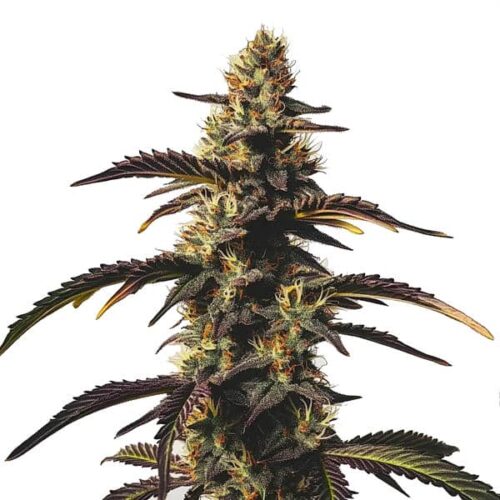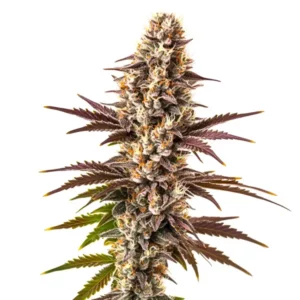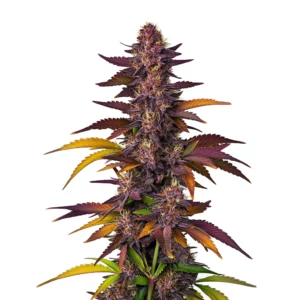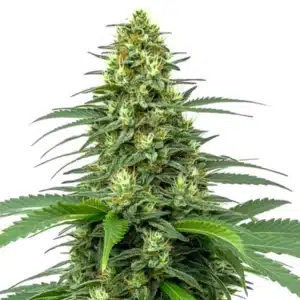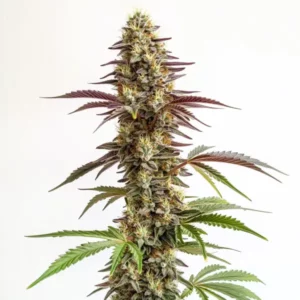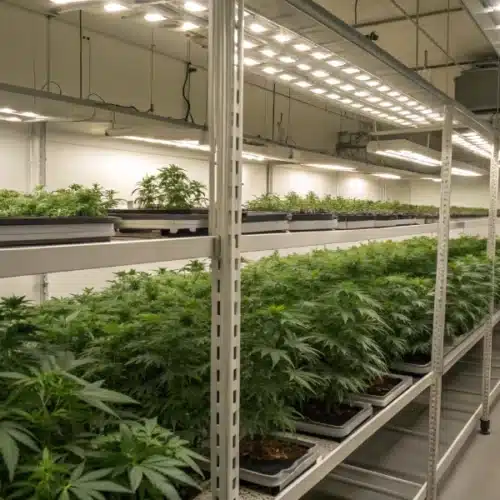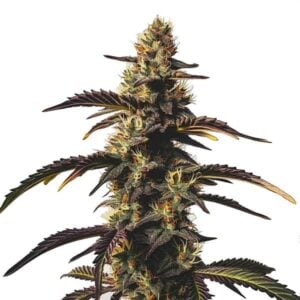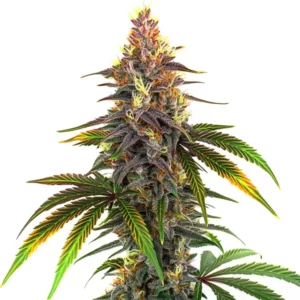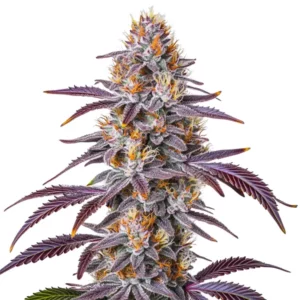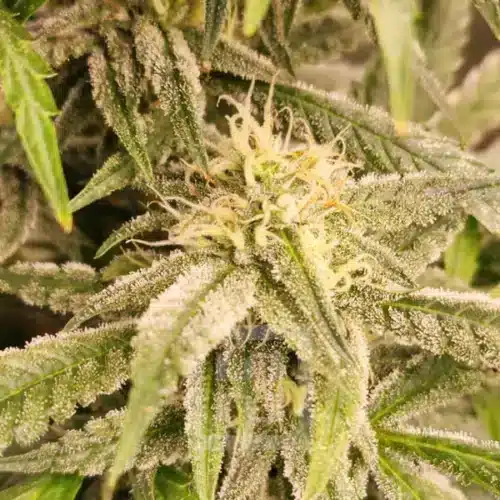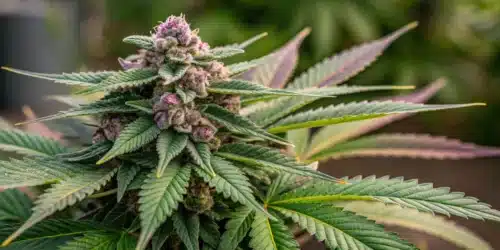Mint Chocolate Strain Description
The Mint Chocolate Strain is a cannabis variety renowned for its mouthwatering combination of minty freshness and rich chocolate undertones. This strain has become a favorite among cannabis enthusiasts due to its potent effects and irresistible flavor profile. A cross between Emerald OG and Granddaddy Purple, Mint Chocolate offers a hybrid experience with a dominant indica influence, making it perfect for relaxation and stress relief.
Recommended Strains
Chocolate Mint OG
 THC: 20% - 25%
THC: 20% - 25% Type of seed: Feminized
Type of seed: Feminized Phenotype: Mostly Indica
Phenotype: Mostly Indica Day to flower: 8 - 9 weeks
Day to flower: 8 - 9 weeks
The dense, resinous buds of Chocolate Mint Strain are visually stunning, often displaying hues of purple and dark green, with a heavy coating of frosty trichomes. The terpene profile features pinene, myrcene, and caryophyllene, which contribute to its unique flavor and aroma. Expect a minty and herbal scent, with earthy and chocolatey notes lingering on the palate.
Mint Chocolate Strain is well known for its high THC content, typically reaching between 20-25%, making it a powerful option for experienced users. Its effects are fast-acting, delivering a euphoric cerebral buzz before settling into a deeply relaxing body high, perfect for evening use. For cultivators seeking optimal results, following a few chocolate mint og grow tips—such as maintaining a stable temperature, ensuring proper airflow, and using nutrient-rich soil—can enhance yield and quality. This strain is also praised for its potential therapeutic benefits, especially for conditions like chronic pain, insomnia, and stress.
Promos & Deals
Environmental Requirements for Growing Mint Chocolate
When learning how to grow cannabis from seed, understanding the specific environmental needs of the strain you’re cultivating is essential. Mint Chocolate thrives in a controlled environment, making it ideal for indoor grows, although it can also flourish outdoors in the right conditions.
Indoor growers should maintain a temperature range between 68°F and 80°F (20-27°C) during the vegetative stage, with slightly cooler temperatures during flowering to encourage color development and resin production. Humidity should be kept at around 40-50% during flowering to prevent mold, as Mint Chocolate produces dense, sticky buds that are prone to moisture retention.
Outdoor growers will need a warm, sunny climate with consistent temperatures throughout the growing season. Mint Chocolate responds well to Mediterranean-like climates, where the natural conditions will allow the plant to reach its full potential. If you’re growing in a cooler region, a greenhouse can be used to extend the season and protect the plants from adverse weather conditions.
Lighting is critical, with high-intensity grow lights like LED or HPS being preferred for indoor cultivation. The strain benefits from a long vegetative period, followed by a 12/12 light cycle during flowering, to enhance bud formation and resin production.
Setting Up the Growing Cannabis Space
Indoor Cannabis Cultivation
To grow cannabis successfully indoors, the Mint Chocolate Seeds needs a well-ventilated and carefully managed grow space. Start by selecting a grow tent that can accommodate the plant’s height and width during flowering. Mint Chocolate Strain tends to develop dense, bushy foliage, so providing enough space for airflow is essential.
Ventilation is another crucial factor. Install fans to keep air circulating, which helps to prevent mold and pest issues. A carbon filter can help control the strong mint and earthy aroma that this strain emits during the flowering stage. Reflective materials like Mylar can be used inside the grow tent to maximize light efficiency.
As for the growing medium, Mint Chocolate can thrive in both soil and hydroponic systems. However, growers using organic soil may find the natural flavors of mint and chocolate to be more pronounced. If you’re using soil, make sure it is rich in organic matter and well-draining. Hydroponic systems may result in faster growth and higher yields but require more experience and maintenance.
Outdoor Cannabis Cultivation
When cultivating Mint Chocolate outdoors, it’s important to choose a sunny spot with nutrient-rich soil. The plant’s roots need space to expand, so consider planting in large containers or directly in the ground if the soil quality is good. Adding organic compost or amendments can boost soil health and improve yields.
Staking or using a trellis system is recommended as the plants grow taller. This support will help manage the weight of the dense buds during the later stages of flowering, preventing branches from breaking under pressure. Proper air circulation around the plants will also help reduce the risk of mold, especially in more humid environments.
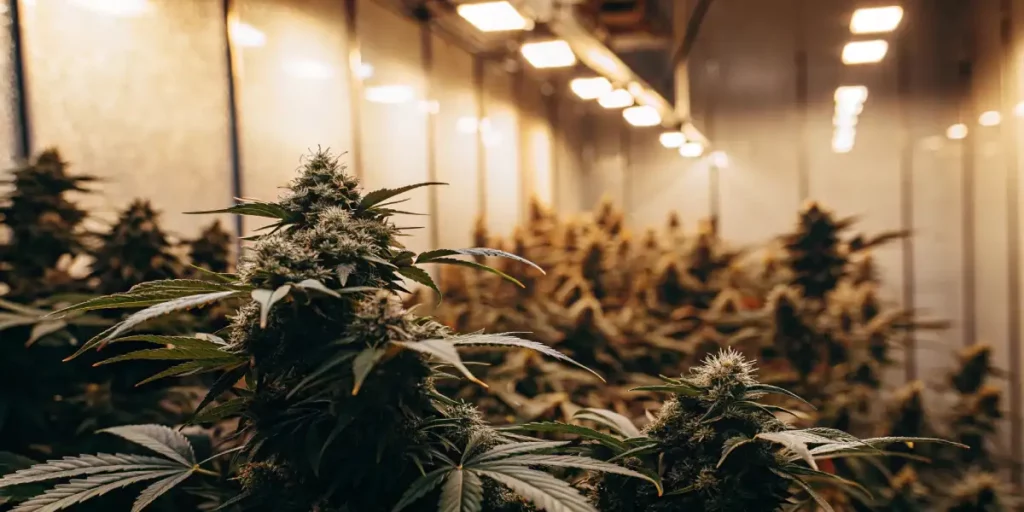
Propagation and Germination of Mint Chocolate
Successful germination is the first step in learning how to grow cannabis from seed. To start, select high-quality Mint Chocolate Strain feminized seeds from a trusted seed bank like Blimburn Seeds, ensuring a stable and predictable genetic outcome.
Soak the seeds in distilled water for 12-24 hours to encourage the germination process. After soaking, transfer the seeds to a damp paper towel and place them in a warm, dark place. Keep the temperature between 70°F and 80°F (21-27°C) to promote healthy taproot development. Within 24-48 hours, you should see taproots beginning to emerge.
Once the taproots have grown to about 0.5-1 inch long, carefully plant the seeds in small starter pots filled with a light, well-draining soil or seedling mix. Place the pots under gentle lighting, avoiding direct sunlight at first. Gradually increase light exposure as the seedlings grow stronger. Ensure the soil remains moist but not waterlogged to avoid root rot.
Within a week, the seedlings should develop their first set of true leaves, signaling they are ready for transplanting into larger containers or the ground, depending on your setup.
Vegetative Phase of Mint Chocolate Strain
During the vegetative phase, Mint Chocolate undergoes rapid growth, developing its signature bushy structure. Proper care during this stage is essential to maximize future yields. This period usually lasts around 4-8 weeks, depending on the desired plant size and growing conditions.
Lighting: Provide the plants with 18-24 hours of light daily, using either LED or HPS grow lights. High-quality lighting is essential to stimulate vigorous growth, with sufficient blue light spectrum during the vegetative stage for healthy leaf and stem development.
Nutrition: Mint Chocolate plants require a nutrient-rich diet during the vegetative stage, with a focus on nitrogen (N), phosphorus (P), and potassium (K). Cannabis-specific fertilizers or organic amendments like worm castings or bat guano can help sustain rapid growth. Keep an eye on any signs of nutrient deficiencies, and adjust feeding schedules accordingly.
Watering: Consistent watering is critical, but avoid overwatering as this can lead to root rot. Allow the top layer of the soil to dry out between waterings. Maintaining a balanced pH level of 6.0-6.5 is also important to ensure optimal nutrient absorption.
Training: To maximize yields and control plant height, consider using training techniques like topping or low-stress training (LST). These methods encourage even canopy development and allow more light to penetrate the lower branches, resulting in more bud sites.
Flowering Phase of Mint Chocolate Strain
Mint Chocolate’s flowering phase is the most exciting part of the cultivation process, as the plant begins to produce its signature dense, resinous buds. This stage typically lasts 8-9 weeks.
Lighting: Adjust the light cycle to 12 hours of light and 12 hours of uninterrupted darkness to trigger the flowering phase. Ensure the plants receive intense light, as this will help them produce large, potent buds.
Nutrition: During flowering, switch to a bloom-specific nutrient formula higher in phosphorus and potassium, essential for bud development. Regularly check for nutrient deficiencies and avoid overfeeding, which could cause nutrient burn.
Temperature and Humidity: Lower the temperature slightly, ideally between 65°F and 75°F (18-24°C). Maintain humidity at around 40-50% to reduce the risk of mold or bud rot as the buds thicken. Ensure good air circulation in the grow space, especially during this stage.
What is the best climate for growing Mint Chocolate outdoors?
The Mint Chocolate Strain thrives in Mediterranean-like climates with warm, sunny conditions. This strain requires consistent temperatures and adequate airflow to prevent mold and mildew.
Can Mint Chocolate be grown indoors?
Yes, Mint Chocolate grows exceptionally well indoors when provided with proper lighting, ventilation, and a well-organized grow space. Indoor cultivation allows for better environmental control, which can enhance yields and resin production.
Similar Strains to Mint Chocolate
If you enjoy Mint Chocolate, you may also want to explore the following strains:
Chocolopez: is a sativa strain with strong chocolate and coffee flavors. It’s a great choice for those who enjoy the rich, dessert-like flavor profile of Mint Chocolate. Chocolopez provides an energizing and euphoric high, making it perfect for daytime use.
Strawberry Banana: is an indica-dominant hybrid known for its fruity and creamy flavor, with hints of sweet berries and slight undertones that can complement a minty taste. While it leans more towards fruity, its dessert-like profile makes it a good alternative for those who enjoy sweet strains like Mint Chocolate.
Do-Si-Dos: offers a sweet, earthy flavor with floral notes and a hint of mint. This strain is known for its potent effects that combine deep relaxation with a sense of euphoria, making it a great option for those who like the balanced effects of Mint Chocolate.
Tips for Professional Growers
For experienced cannabis cultivators looking to get the most out of Mint Chocolate, here are some advanced tips:
Maximizing Yield: Professional growers can use advanced techniques like ScrOG (Screen of Green) to increase yields. This method helps create an even canopy and maximizes light exposure, ensuring that all bud sites receive optimal light. Combine this with topping and LST for the best results.
Boosting Terpene Production: To enhance the unique minty and chocolatey flavors of the strain, focus on terpenoid production. This can be done by slightly lowering the temperature in the last few weeks of flowering, ensuring the plant is stress-free, and using supplements designed to boost terpenes.
Managing Nutrients: Mint Chocolate is sensitive to nutrient imbalances, so be sure to monitor pH levels closely, especially in hydroponic systems. For soil growers, organic compost teas or worm castings can provide a slow-release nutrient source that prevents overfeeding while enhancing flavor.
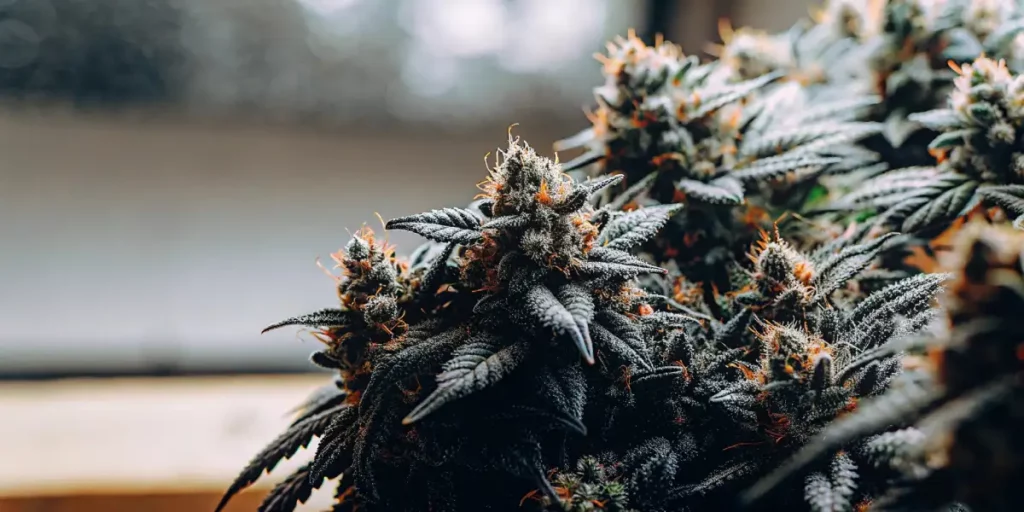
Harvesting and Curing Mint Chocolate
Proper harvesting and curing are essential to maintaining Mint Chocolate’s potency, aroma, and flavor. Harvesting typically occurs around week 8-9 of flowering, though some phenotypes may take slightly longer to fully mature.
Trichome Maturity: The best time to harvest Mint Chocolate is when the trichomes turn from a milky white to amber. This indicates that the cannabinoids have reached their peak potency.
Harvesting Process: Use sterilized scissors to cut the branches. Remove large fan leaves and hang the branches upside down in a dark, well-ventilated space. Maintain a temperature of around 60-70°F (15-21°C) and a humidity level of 50-60% during the drying phase. This process typically takes 7-14 days.
Curing: After drying, carefully trim the buds and place them in airtight glass jars. Store the jars in a cool, dark place and open them daily for the first week to release excess moisture. After the first week, open the jars every few days to allow for proper curing, which usually takes 2-4 weeks.
Problems in Growing Mint Chocolate
While Mint Chocolate is a resilient strain, growers may encounter certain challenges during cultivation. Here are a few common issues and how to address them:
Temperature Stress: Mint Chocolate is sensitive to temperature fluctuations. Ensure that temperatures remain stable, especially during the flowering phase, as excessive heat can lead to airy buds or diminished trichome production. Use fans or air conditioning in hot climates and ensure proper ventilation in indoor grows.
Overfeeding: One of the most common issues with growing Mint Chocolate is overfeeding. This strain does not require excessive nutrients, so it’s crucial to follow a measured feeding schedule. If signs of nutrient burn appear, such as yellowing or curling leaves, flush the soil with water to remove excess salts.
Pests: Choco Mint Strain is susceptible to common cannabis pests like spider mites and aphids. Regularly inspect the plants and implement organic pest control measures, such as neem oil or predatory insects, to keep infestations at bay.
FAQs
How long does it take for Mint Chocolate to grow from seed to harvest?
Mint Chocolate Strain typically takes around 8-10 weeks to flower. From seed to harvest, expect a total grow time of approximately 12-14 weeks, depending on environmental conditions.
What is the ideal growing medium for Mint Chocolate?
Mint Chocolate thrives in both soil and hydroponic setups. However, for a more robust flavor profile, many growers prefer using organic soil rich in nutrients.
How can I improve the flavor of Mint Chocolate?
Improving the terpene profile of Mint Chocolate can be achieved by lowering temperatures slightly during the last weeks of flowering and using terpene-boosting supplements. Organic soil or compost teas can also enhance flavor development.
What is the THC content of Mint Chocolate?
Mint Chocolate typically boasts a THC content ranging from 20-25%, making it a potent choice for experienced cannabis users.
Is Mint Chocolate easy to grow?
Mint Chocolate is moderately easy to grow, making it suitable for both beginners and experienced cultivators. However, it does require careful attention to temperature and humidity, especially during flowering.

